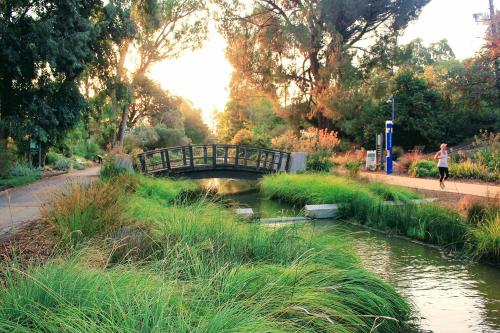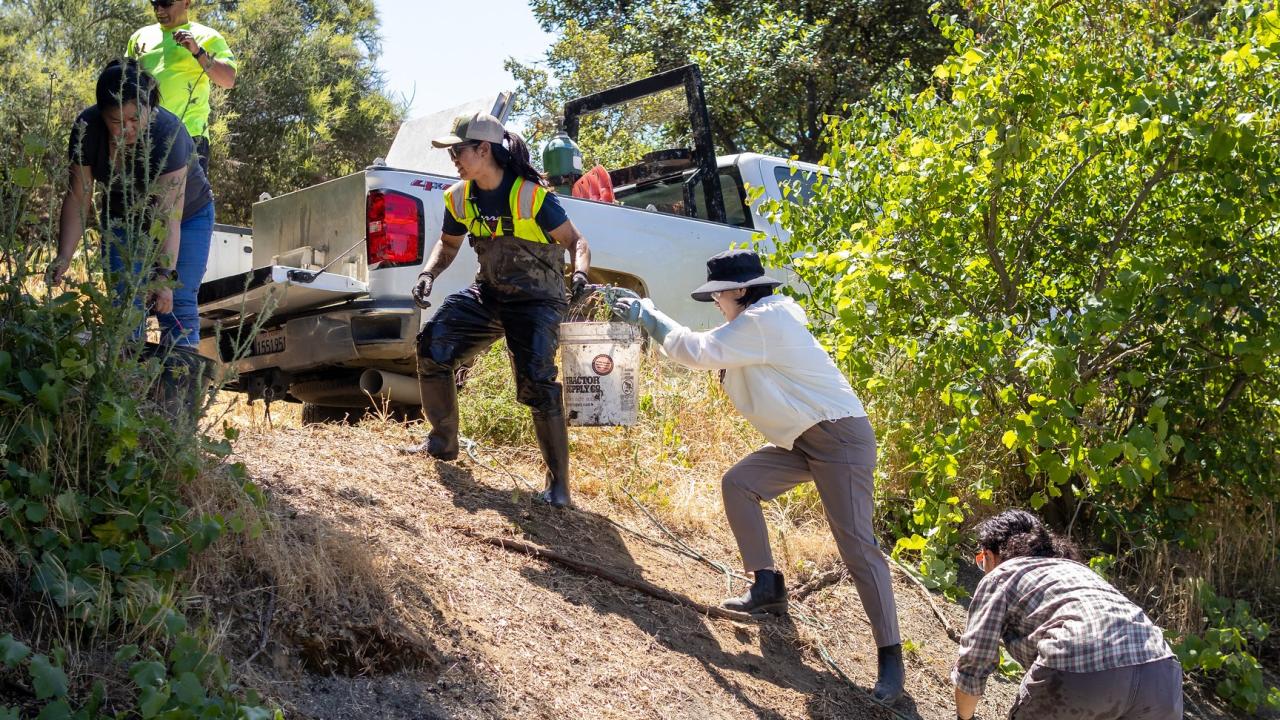Sustainable Solutions for our Campus Community:
The Arboretum Waterway Flood Protection and Enhancement Project

In 2016, UC Davis embarked on an ambitious project to enhance the Arboretum Waterway. Following the successful completion of
the first phase, additional funding was secured to continue the improvements. Construction resumed in March 2024 and is expected to be completed in 2026. This massive undertaking aims to significantly enhance campus sustainability, research opportunities, and aesthetics. We sat down with landscape architect Andrew Fulks, who played a major role in launching this project, to learn more about the innovative changes taking place.
Background and Involvement
The Arboretum Waterway is a stagnant body of water that was once connected to Putah Creek. As the UC Davis campus grew, campus planners decided to use the basin as a stormwater system, pumping water from the waterway back into the creek after large rain events. The waterway continues to be the backbone of the campus stormwater system and the outlet for all of campus’ recycled water.
Before this project began, Associate Vice Chancellor Bob Segar tasked Andrew’s team with finding a solution to issues with algae and duckweed infestations in the waterway. Engineers had previously looked into the problem and provided solutions for dealing with the algae after the fact, such as installing an algae harvester. However, Andrew saw the need for a holistic transformation of the entire system. In a stagnant body of water such as the Arboretum Waterway, there is no way to prevent surface algae from growing. However, in a moving body of water, this surface algae is broken up! To improve the look of the waterway, the Arboretum and Public Garden team needed to find a way to mimic a natural flowing body of water.
Finding a Solution

Andrew proposed an innovative solution: creating an elevation gradient, coupled with recirculation pumps, to introduce water
movement into the waterway. By installing infrastructure to stair-step the water's elevation, the team could simulate the benefits of a naturally flowing water system. This would not only break up surface algae but also improve the water's dissolved oxygen levels. A mini-project demonstrated the effectiveness of this approach, leading to funding for a larger-scale study.
The first phase of the project was implemented using deferred maintenance funds and has proven to be successful. This led to additional funding for the rest of the project.
Changes being made to improve the waterway also include removing the current concrete edge and replacing it with earthen banks planted with native vegetation. This will allow for increased area for wildlife and plant habitats and limit flood risk. Wildlife drawn in by the improvement will also provide researchers with ample opportunities for study!
Campus Collaboration

Countless students, engineers, researchers, and campus partners have been instrumental in the success of this project, says
Andrew. Utilities, Safety Services, Campus Planning, Design and Construction Management, and Campus Communications are just a few of our campus teams who have dedicated their time and resources to the project. Students have been able to lend a helping hand through the Arboretum and Public Garden’s Learning by Leading Waterway team. The team conducts biological surveys, monitors water quality, and provides other assistance essential to the project’s success. Andrew made sure to thank the entire FOA team, stating that the project “wouldn’t be possible without them”!
Additionally, consulting biologists, engineers, and geotechnicians have paved the way for success by offering insight into how the project should proceed. Other outside organizations such as the Sacramento Valley Conservation Corps, the Center for Land-Based Learning, and the former Water Resources Association of Yolo County have played a role in refurbishing the waterway as well.
Community Impact
Both the UC Davis and the city of Davis communities have been looking forward to the implantation of this project, says Andrew. Many have complained about the appearance of the waterway and are excited for its new look! With the algae, drain pipes, and broken concrete removed, the waterway will look refreshed and draw in many new visitors, from community members to new wildlife. Andrew expects new bird species to inhabit the Arboretum with the planting of native vegetation, attracting bird watchers from all over the area.
A Model for the Future
Improvements from this project are expected to last into the foreseeable future! After the last phase is completed, regular upkeep will have to be done to maintain vegetation and prevent overgrowth.
Andrew remarks that this project is the first of its kind and will likely inspire similar projects across the state or even the world. He is so grateful to be working with a team that is so good at what they do and is proud to be creating sustainable infrastructure!
More information, construction area graphics, photos, regular updates, and more are available at the UC Davis Arboretum and Public Garden Waterways project web page!